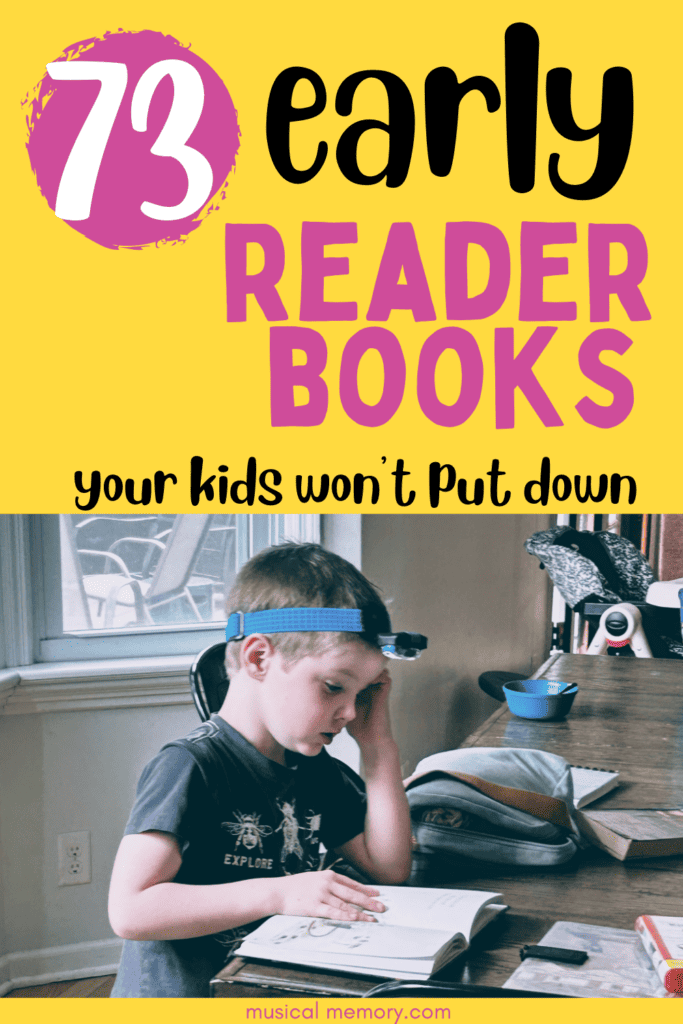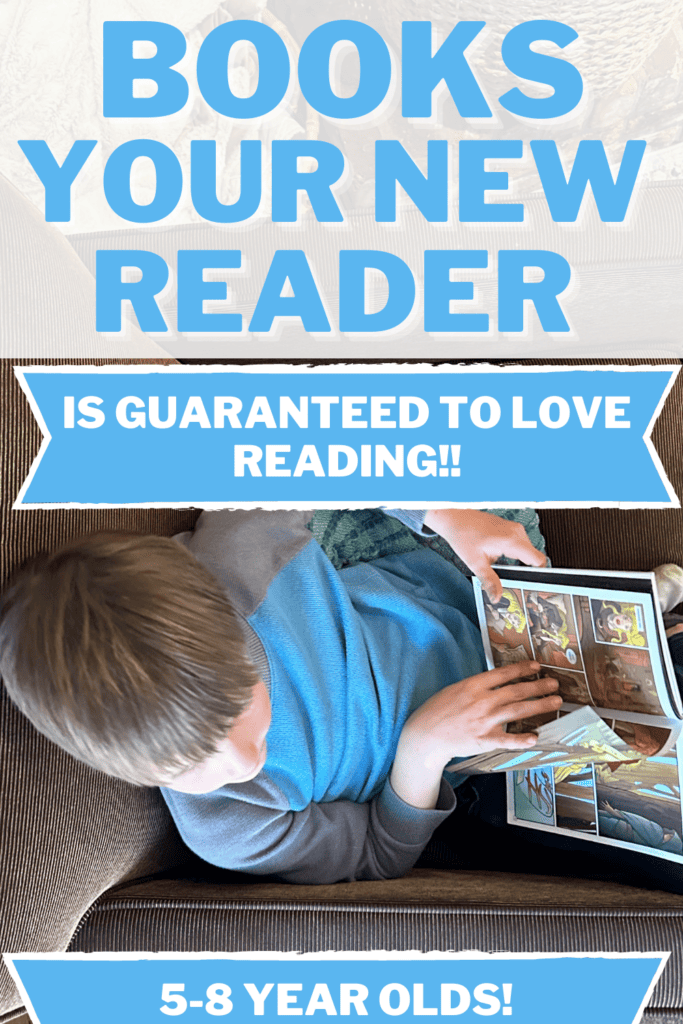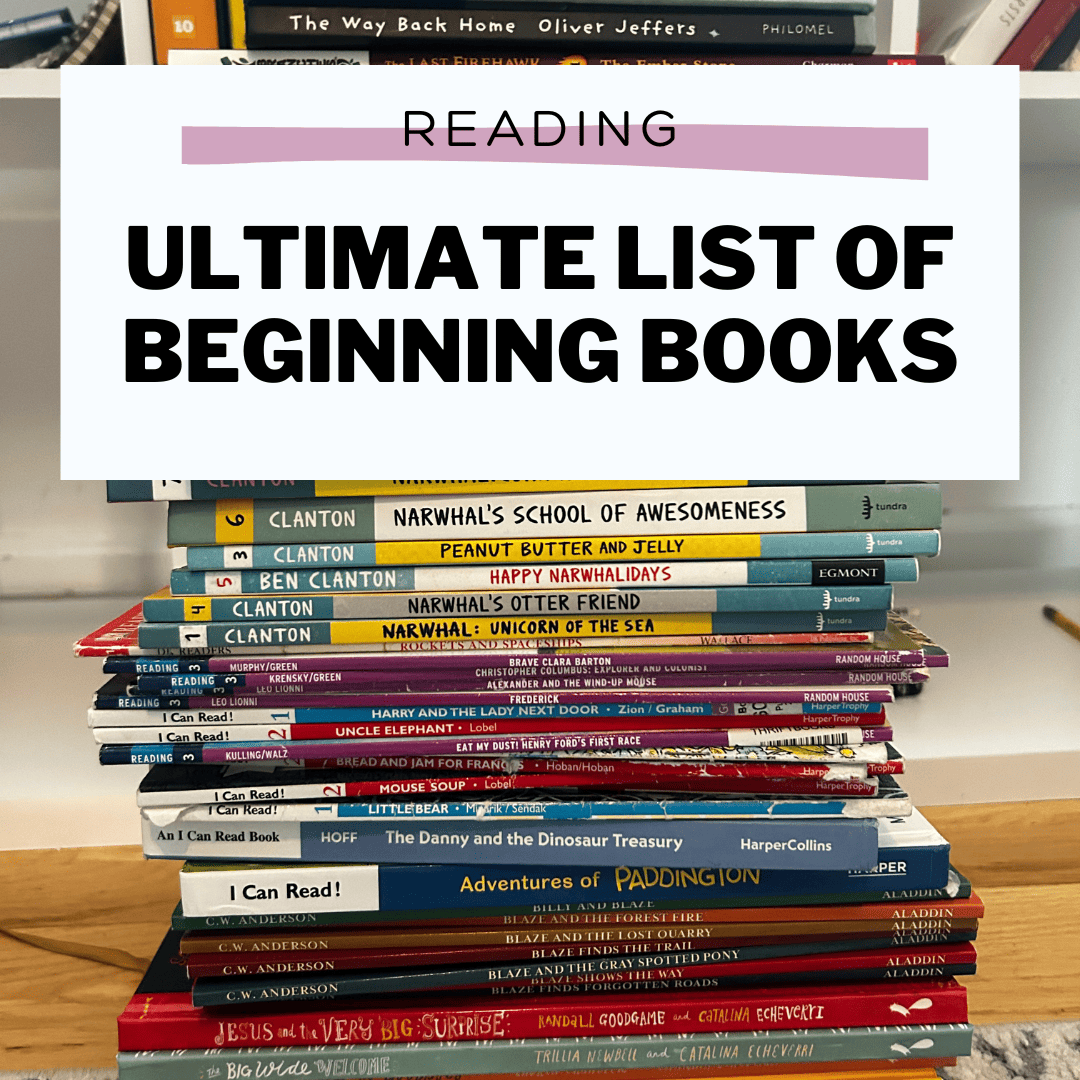Wondering what to read with your young readers? I’ve taught all four of our kids to read at home. I love finding good books and I much prefer to read cute, engaging, beginning reader books compared to books like “The fat cat sat… the fat cat is mat.”
Granted, there are some of those books on this list because that’s unavoidable for the very early reading days, but still!! There are TONS of other great beginner reading books that you’ll both actually enjoy.
Grab a cup of coffee and cozy up to this list because these are all the books our family as enjoyed over and over with brand new readers, emerging/ beginning readers, advancing readers, and legit kids who can read any books they want!!
Phase 1: Brand New Readers – The Fat Cat…
If you have a child who is just beginning to sound out words, I recommend mostly just sticking to writing CVC words on a dry erase board or piece of paper and spelling them out/ sounding them out together.
I write simple sentences on a white board for reading practice. You can even write short sentences one word at a time to keep things interesting.
If you’re really feeling creative, staple a few small pieces of paper together and write silly sentences on each page one word at a time. Let your child help you come up with rhyming words. “Write a book” together that they can read over and over.
Having your child learn all 75 basic phonograms and write simple words one at a time is the best way to improve fluency and expand how many words they can read quickly.
If your child can’t read basic Consonant vowel consonant (CVC) words, I do not recommend starting on the books below. Most will be overwhelming!! Stick to building and sounding out words.
Once the child can read something like “I see a bug,” you could try some of the following books for more fluency practice.
Run, Bug, Run! & The Runt Pig
This is my all time favorite easy readers series for beginner readers. Run Bug Run is my go to first reader – no matter how old the child is.
These beginner reading books are legitimately good books, published by All About Learning Press, which publishes reading & spelling homeschool curriculum. (Snag them here under “Individual Products.”)
I don’t know how they’re so cute with such simple sentences – they just are. My kids all loved these around age 5 years old.
Actually, I would just go ahead and buy all 3 Level 1 Reader books at once from this company, though the 3rd book is on the next level of reading list. You don’t need the whole program. The books stand alone! These early readers are full of cute stories that are actually enjoyable to read. My kids have loved these books.
FYI – The older edition is in black & white, if you’re looking for used copies on Thriftbooks or Ebay. The illustrations in the newer edition are in color. Both are great options.
These first two level one books (which are almost all short vowels words) can be purchased for ~ $23.00 here under “Individual Products.”
Fun in the Sun
This is a my other favorite book for brand new readers. It has several short stories & cute pictures… more short vowel practice. My kids love this one! And it’s usually priced under $15! A TON of stories in here.
Sometimes I’ve played a game where I cover the picture with a piece of construction paper before they start reading. After the child reads the story, they get to see the accompanying picture. This book starts out very gently with only a few words per “story.” It builds gradually in length. There are x short stories in this book. It might be the only one you need.
BOB Books Beginning Readers Set
These traditional Bob Books are cute, tiny books that kids seem to love!! They’re basically short words with stick figure drawings, but for some reason they’re timeless. Haha. All my kids have loved working their way through the BOB Books set. You can often even borrow a whole box set from your library.
Dash into Reading is like the new Bob Books, but quite a bit more expensive. The illustrations are too cute to boot, but you have to shell out a bit more for these. If you have several children, you might get your money’s worth. Up to you!
You could literally make up your own books, you guys!! You just need pieces of paper with cute pictures that say, Mat has fun. Fun in the sun. And stuff like that.
Truthfully, at this stage, most of our “reading practice” is done on white boards, notebooks, in the sand tray, and with phonogram practice. But it IS fun to have a few “real books” around to read too.
Teach Your Child to Read in 100 Easy Lessons
I used this book as scripted with my first child and there were tears by lesson 50. Whoops! She was only 4, sooo it wasn’t really designed for four year olds to use as scripted.
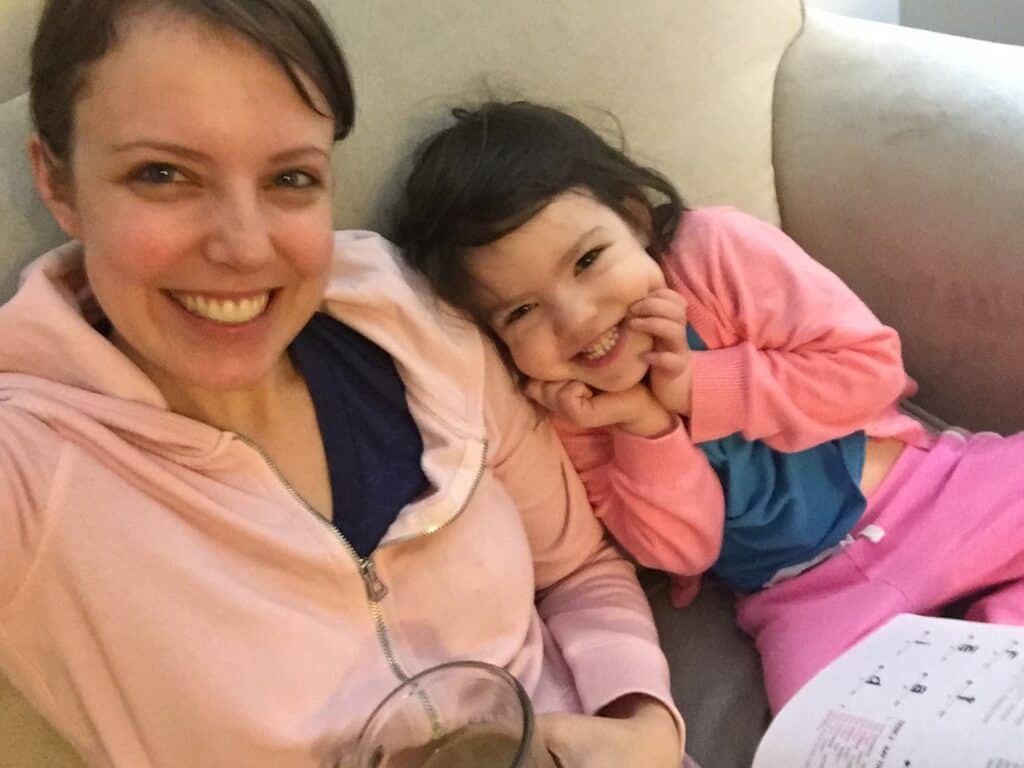
Now that I know my ABCs of teaching kids to read, I actually do like using this book as just another book we can practice reading from.
Though it’s not the right book for everyone, it has some built in rhyming & blending games. My kids like the big easy-to-read text, and the silly pictures that go with the stories. (I cover the picture with a giant post it note or piece of construction paper. Then after the child reads the story or sentence, they get to uncover the picture. They love this!)
I also have the kids practice the letter sounds that are marked in the book. (line over the top of a vowel indicates a long vowel.) The fact that their marking system is different from my marking system when I teach spelling doesn’t seem to confuse the kids.
After 6 years of homeschooling, I now think of any curriculum as a tool to serve our purpose. The curriculum is not the boss of us and we are not enslaved to curriculum scripts and processes. Most curriculum has more in it than you will ever need to use. Pick & choose what works for you and your child(ren)!!
AAR – The rest of the books
I’d recommend working your way through the All About Reading Leveled Readers one by one until your child is very fluently reading the 3rd or 4th level books. They are about $22 each, and each book has many stories. The readers usually take us a few months each, having the child read aloud with me a few times a week for 10-15 minutes total.
Personally, I think they are the absolute best early reader books (pictured on the bottom below.)
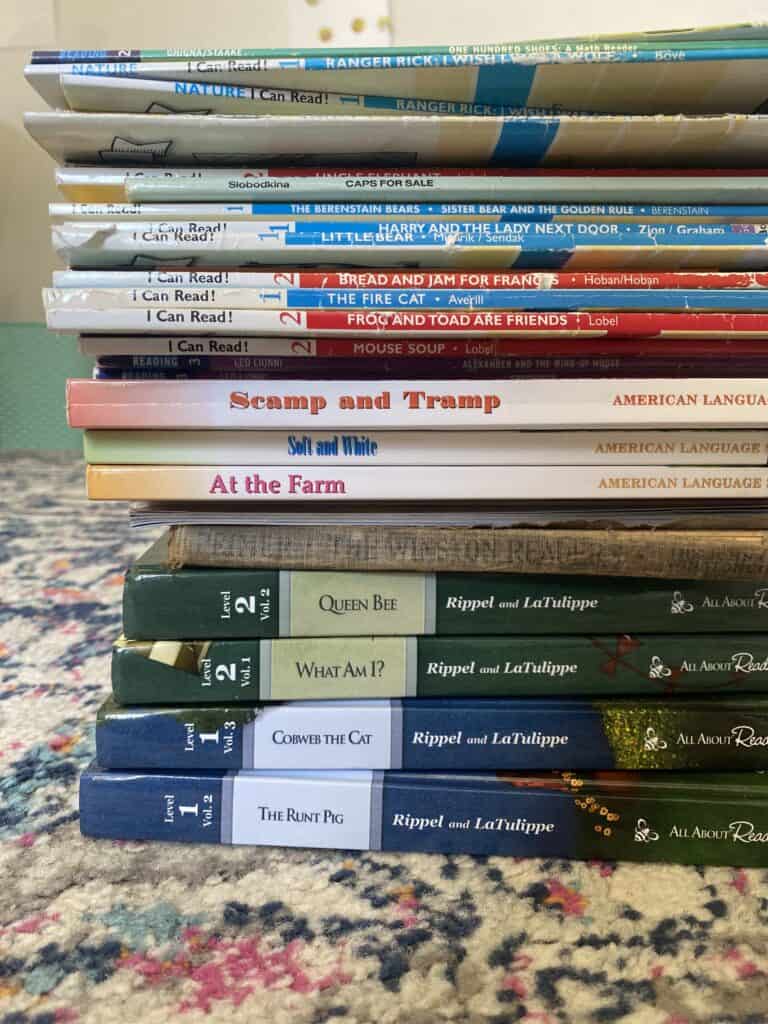
The website is initially a tad confusing, but you just go to the level you want to buy, scroll down to “Individual Products,” and add the Reader Books to your cart. They are around $23 as of this article writing.
Run Bug Run is absolutely my favorite first reading book for 5 year olds!
Level 1 – There are 3 books and the first two were on my above list for brand new readers. The third book, Cobweb the Cat is next up! (This book works for the next level – Emerging Readers)
Level 2 – What Am I? and Queen Bee. I’m literally nostalgic typing this. My kids loved these. (These work for the advancing readers leveled books below.)
Level 3 – Chasing Henry and Shipwreck (These work for the advancing readers leveled books below too.)
Level 4 – By this time, your child may just want to move on to other books. But these short stories are entertaining and sweet, so if your child enjoys them, I’d say keep reading. (These are great for bridging the gap to beginning chapter books. There are harder words in these than most beginning chapter books, but they are illustrated and have fewer words on the page, so that’s helpful for some kids. Most of my kids, honestly, lost interest when we got to level 4. They just enjoyed picking out their own books at the library.)
My beginning reading workshop is for anyone who is helping their child learn to read at home! Whether you have an eager 4 year old or a struggling 9 year old, this video based workshop will teach YOU everything you need to know about helping your kids learn to read. (And it comes with all the materials you need too.) Learn more about it by clicking here.

Phase 2: Emerging Readers – Bud was Pug’s Pup. Great!
These are readers who can read something like this very easily: “Bet was Bob’s kid. Pug was Bet’s dog. Bud was Pug’s pup. Bob sat on a rug. Bet sat on Bob.” (That’s from one of the last little books in the BOB Books beginning reader’s box set.)
No Reading Tears!! Tip for Reluctant Readers
My best tip for kids who are learning to read is take turns reading aloud as frequently as needed. If you have a kid who expresses any sort of reluctance, I’d sit and read with them for 10 minutes a day, taking turns every sentence, paragraph or page.
Sometimes I read the first full chapter or few pages and then we start taking turns. This helps them get into the story! Eventually, your child will start reading for longer and longer chunks, as it feels easy to them.
I really don’t think it’s ever worth tears for reading aloud. Take turns every word or sentence if needed. Set a 5 or 10 minute timer and have your child, “try your best” taking turns. They will get it eventually.
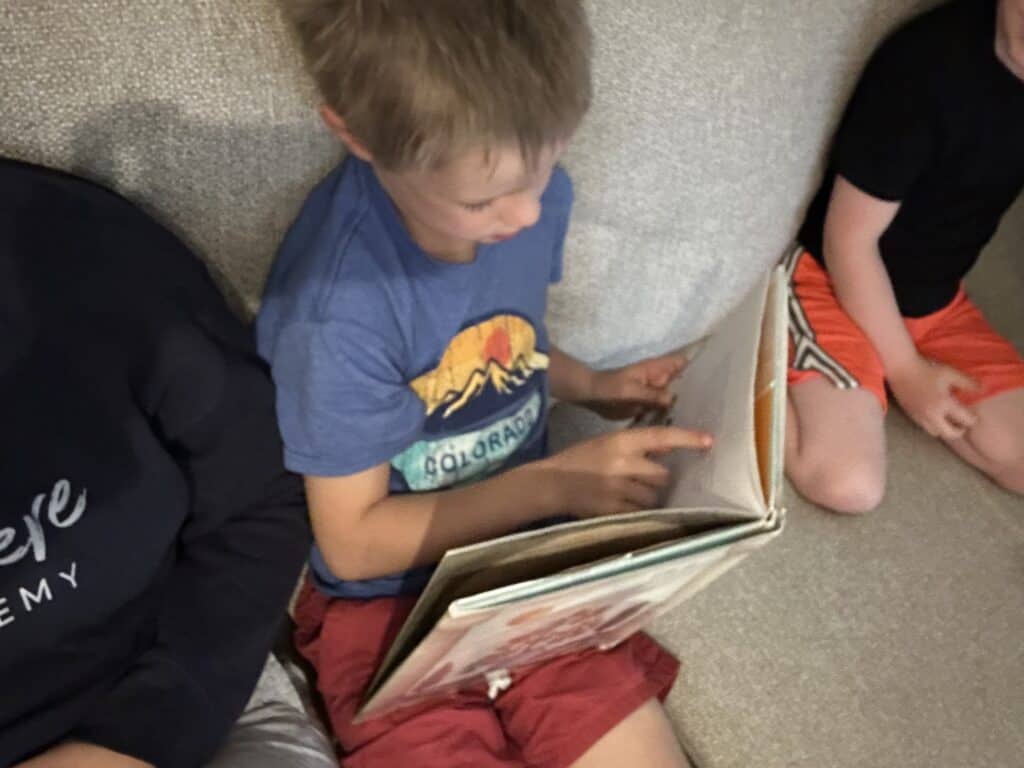
BOB Books – Set 2
The next level of BOB books is a good transition set for kids who need the pages to be short & sweet still. Some kids will want more practice like this, and some will think they’re boring or “babyish” by now. Just read what works for your child.
The Good and the Beautiful Nature Readers
You could use My FIRST Nature Reader or My SECOND Nature Reader depending on your child’s progress. This company teaches “sight words,” which I don’t like for this age. I strongly recommend teaching all 70-75 phonograms in an ongoing way which will allow new readers to decode words like they, them, school, sight, etc. rather than only teaching a handful at a time and calling all other words “sight words.” Most “sight words” are actually able to be decoded phonetically.
If you’re teaching all the phonograms, then the 1st or 2nd nature readers will be enjoyed by your emerging readers!
Elephant & Piggie Books (Mo Willems)
These are so fun for emerging readers. My kids and I love to take turns with the characters. I’ll be Piggie for one read-through and the child will be Elephant. Then we’ll switch or read another one. Piggie & Gerald are best friends, and these books have been best friends to my kids as they learned to read.
We love these collection volumes. There are 5 of them now!
One reason I love these is that they don’t rely on some random list of “sight words.” Many of the words in the books are simple words, but sometimes there are more complex words to decode. Or you can just tell them to your kids.
National Geographic Readers – Levels 1-3
These nonfiction books are so cute, and they have great pictures. (If you have kids who love animal facts and Wild Kratts, these will be a perfect choice at your house.)
Our library has these and all of our kids have enjoyed them. We even own a few too – they’re so cheap and the photographs add a fun variety from regularly illustrated picture books for kids this age.
- Level 1 National Geographic Books
- Level 2 National Geographic Books
- Level 3 National Geographic Books (fits more in the “Advancing” category below)
Narwhal and Jelly
This series is adorable!! Anything by Ben Clanton is so fun. When our 3rd child was 6 years old, he was obsessed with these. He read them over and over (which is great for fluency practice) and would laugh out loud every time. Because they’re not designated “easy reader books,” they’re legitimately enjoyable for anyone. My advancing readers & older kids love them too.
Big Red/ Purple/ Orange/ Blue/ Green Book of Beginner Books
Most of these are Dr. Seuss and P.D. Eastman books. Each is a great compilation of early reader books, though these truly aren’t my favorite compared to the other options in this section.
Kids seem to love the pictures and an emerging reader will gain confidence from a lot of repetition, so they’re good options for independent reading at bedtime or something.
Phase 3: Advancing Readers – Frog and Toad are Friends
These are readers who can read many basic picture books and classic “beginning reader books,” like Frog and Toad. These books have a much wider vocabulary in them and some of the words will be difficult for your advancing reader.
Still, advancing readers are likely to really begin enjoying books. If your child has any sort of reluctance, follow the tip above under the heading, “No Reading Tears.”
Don’t stop reading aloud to your kids at this stage!! Kids at this age can enjoy many wonderful novels read aloud to them.
And don’t stop having them read aloud to you. (For my kids in this stage… We keep chugging through the level 2 and 3 AAR readers a few days a week with the 10-15 minute take-turns-reading-aloud sessions.)
But in terms of independent reading… here are our favorite suggestions. Our copies of these books are extremely well worn.
TIP – ask grandparents for sets/ series of books for gifts! Gifting reluctant readers a big set of one book series is a great way to foster a love of reading. They’ll fall in love with the main characters in most of these books too.
Top 6 Favorites to Start With
- Billy and Blaze series – these are so much fun and have sweet character development. I bought the box set as a gift for one kiddo finishing a reading chart & they have been SO well loved by our whole family.
- Narwhal and Jelly series (also listed above) – these are such a fun first book! I love gifting a few to a 1st grade or second grade birthday kiddo.
- Mighty Jack & Zita series – These are graphic novels & there are 5 books total, by Ben Hatke. There are 2 Mighty Jack books, 2 Zita the Spacegirl books, and then the characters overlap in a book called Mighty Jack & Zita. Anything by Hatke is wonderful!
- Anything by Leo Lionni – Frederick, Swimmy, An Extradordinary Egg… another favorite author of mine! Advancing readers can read his books AND your whole family can enjoy them as a read aloud.
- Folk Tale Classics Treasury by Paul Galdone – my kids and I have read this book (together and independently) so many times, our copy is well worn.
- The Beginner’s Bible – This is a classic children’s Bible with simple retellings of many Bible stories.
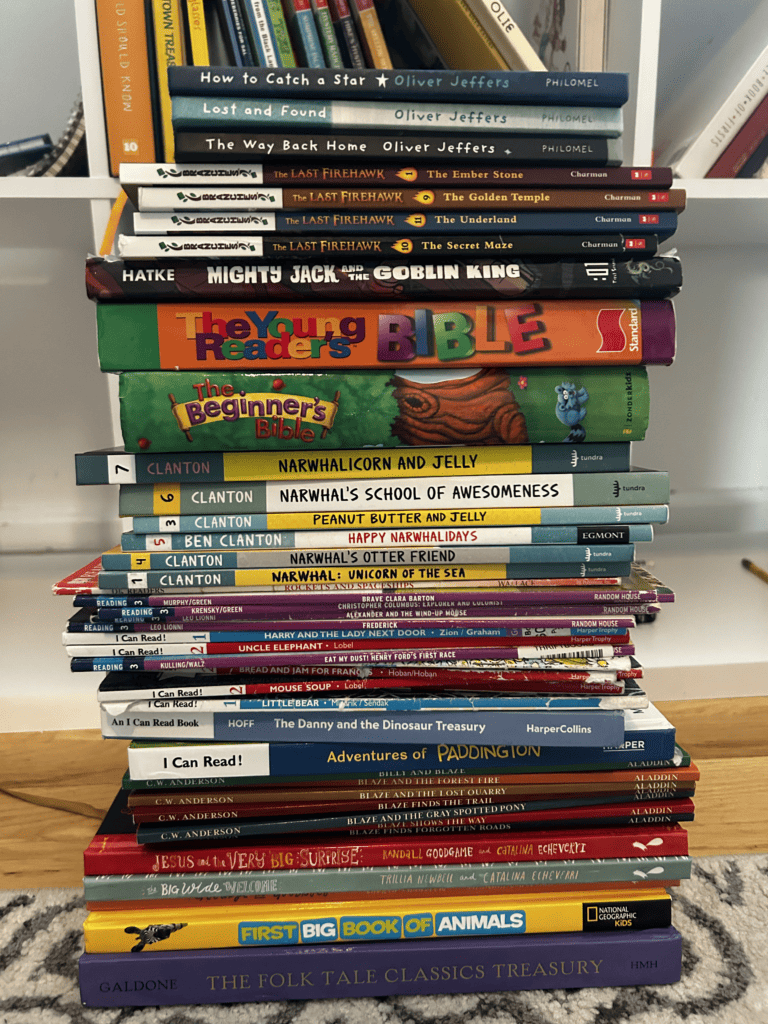
The thing about this level of reading is that it’s starting to become really fun for kids!! So I am usually trying to find allllll the books they can enjoy. Kids this age usually get into series too, so several of the recommendations below are in a series. These are great ones to get from the library! If your kiddo falls in love with a character, it might be worth buying the series.
- I can read! Adventures of Paddington
- Danny & Dinosaur Treasury
- Almost anything by Arnold Lobel – Frog and Toad, Mouse Soup, Uncle Elephant, Grasshopper on the Road… he’s one of my favorites.
- Little Bear Books – these are classic learning-to-read books by Else Holmelund Minarik and Maurice Sendak
- Frances Books
- Arthur’s Loose Tooth (Hoban)
- Berenstain Bears Series
- Original Amelia Bedelia Books by Peggy Parish
- Mr. Putter & Tabby series and Henry & Mudge series, both by Cynthia Rylant
- Step into Reading Level 3 – These are my favorite nonfiction “leveled” books. We have many of the history ones, including: The First Thanksgiving, The True Story of Pocahontas, Eat My Dust!, Abe Lincoln’s Hat, and The Bravest Dog Ever! There are some great science ones too!
Phase 4: Beginning Chapter Books & Graphic Novels
It’s okay if it takes your kids years to work through the levels on this list! Pin it, save it, flag it, or whatever so that you can refer back to it for years to come.
Also, start becoming a great book finder for your kid. Anytime your child likes an author or series, put the rest of it on hold at the library. Find a few websites or Instagram accounts whose kids’ books you like and save those for easy reference.
- Firehawk Series – these are some of the BEST chapter books for even the most reluctant reader who is nervous about tiny words and no pictures. (I’ve had a couple of those!)
- Mighty Jack/ Zita series graphic novels/ comic books (also mentioned above)
- The Big Balloon Race
- The Golly Sisters Go West
- Hill of Fire
- The Young Reader’s Bible – I LOVE this one!! So do my kids!
- Sam the Minute Man
- The Smallest Cow in the World
- Daniel’s Duck – This is by Clyde Robert Bulla, who is one of my favorite authors for kids at this age.
- The Chalk Box Kid – one of my favorite first chapter books to take turns reading aloud with a kiddo
- The Paint Brush Kid – the sequel to the above book
- All other Clyde Robert Bulla books – haha! They’re so good.
- Magic Treehouse Graphic Novels – these are a lot of fun! My kids like the original Magic Treehouse books too, but the graphic novels are a huge hit around here. They’re great historical fiction for independent reading.
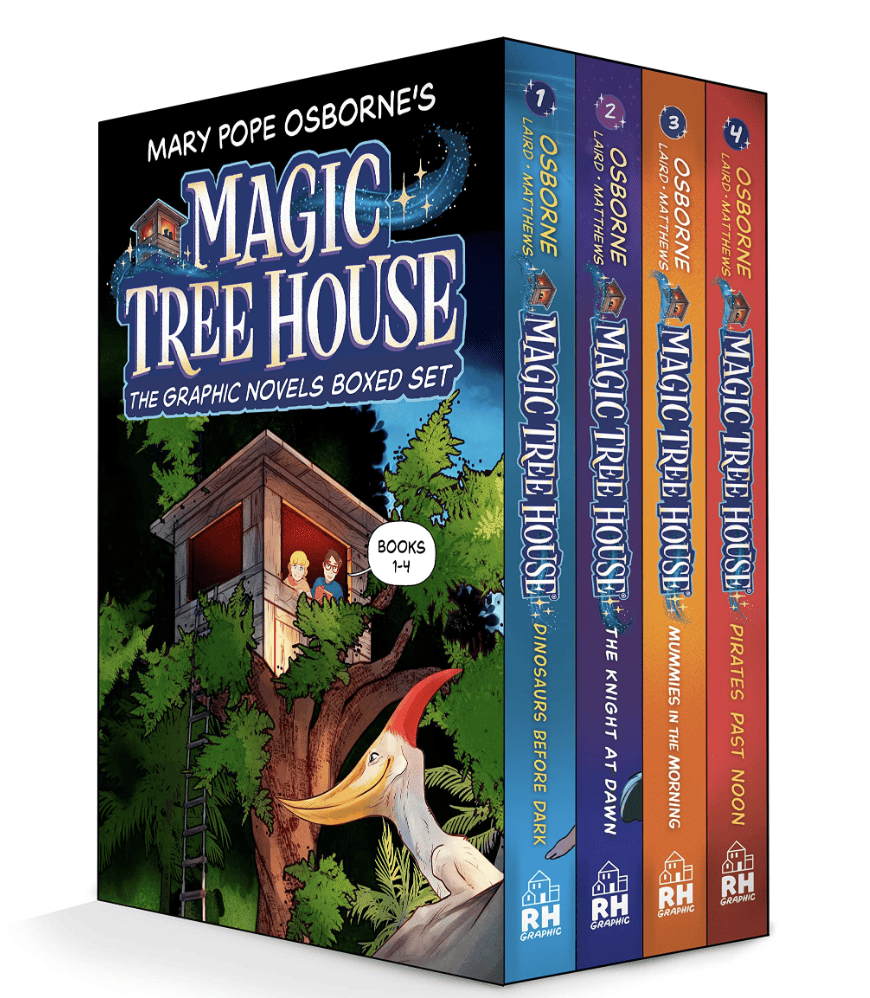
Yay! Your child can read for fun!!
At this point, it really becomes a game and a journey of finding books your kid loves and challenging them to read books they might not think they’ll love but will end up enjoying. Hopefully by now your kids love reading books. We’re always balancing the following types of reading in our home:
- Mom reading to kids for various subjects – History, Bible, Science, Literature Poetry (homeschool life!!)
- Mom outsourcing the above subjects to audiobooks on Scribd & Libby
- Mom or Dad (or family audiobooks) reading aloud fun novels – Narnia, A Place to Hang the Moon, Heidi, The Hobbit, etc.
- Kids reading or listening to audiobooks independently
- We do homemade February and/ or summer reading challenges to track minutes for reading prizes as well.
My favorite books about books are:
- Read Aloud Handbook (7th edition in particular because it’s the last one the original author compiled)
- The Read Aloud Family
- Honey for a Child’s Heart
- Caught Up in a Story
- Book Girl
Some of a my favorite websites/ online accounts for getting book recommendations (for myself and kids) are:
- Read Aloud Revival
- MENSA lists
- Newberry Winners over the years – Newberry medals go to “middle grade” novels… great for reading aloud to all ages, but note the content in case it’s too mature for your young children.
- Caldecott Winners over the years – Caldecott medals go to the best picture books for all ages!
- Coretta Scott King over the years – This award goes to the best picture books & young adult books that represent African American culture & influence.
- @delightfullyfeasting (instagram)
- @lovingleadinglittles (instagram)
- @cirquedusewell (instagram)
TIP – whenever I see a book post I like on Instagram, I save it to a “books” folder on Instagram and the I can go back and find it later.
Building a Reading Habit
One of the most important (and sometimes overlooked) factors in building readers is having a culture of reading at home.
It doesn’t seem like just reading together would contribute to reading skills. But it does!!
Read to your kids as many days as you can every week! Play audiobooks in the car, check out fun books from the library, read a picture book over lunchtime. Whatever you can do to build a reading habit in your family.
The joy of reading is caught through the memories of sitting around and enjoying books together. Don’t turn these cozy reading sessions into phonics lessons either. The primary goal of reading aloud together is just enjoying the power of stories.
If you want to be inspired to read aloud more to your kids, these are my all time favorite books about reading:
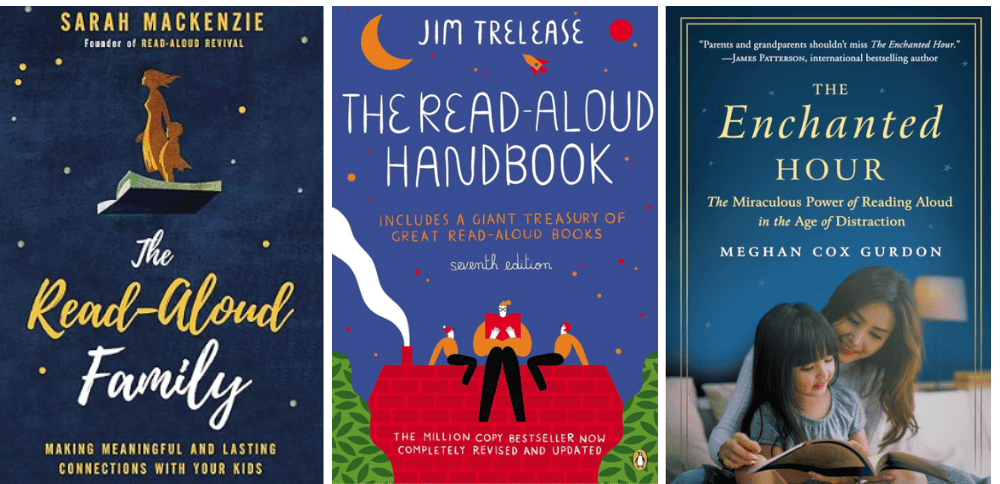
Teaching Your Child to Read
I have several posts on how to teach your child to read & an online workshop that walks you through the entire process of teaching your child to read at home in a simple way, start to finish.
If you want help in this area, I’d recommend reading the following posts and getting the starter phonogram kit & workshop bundle!!
- Is your child ready to read!?
- What are phonograms? They might not be what you think…
- How to teach reading with phonograms
- The only blending game you need to play with your 3-5 year old
